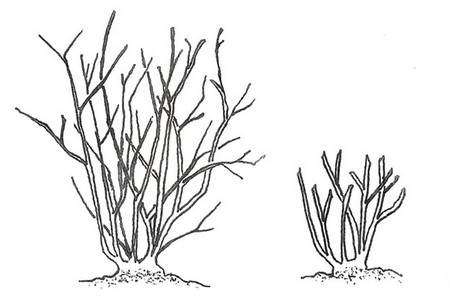The answer is YES! And it is easy!
If you prune, your rose flower bushes will
• Be larger
• Have more flowers
• Will be more balanced and fuller
• And the health of your plant improved!
Most roses need to be pruned only once a year. All types of rose bushes benefit from pruning and if roses are not pruned regularly, they deteriorate in appearance and flowers will become smaller.
When to Prune?
Most roses should be pruned when they are dormant. In this area of California, roses are generally dormant between December and February and anytime in that time frame is fine.
Objective
The pruning objective is to work toward an open, airy, well-shaped and balanced V-shape cane structure.
What you will need
• A pair of sharp, clean pruning shears
• A pair of clean long-handled lopping shears
• Thick gauntlet gloves to protect your hands from the thorns
• A small hand saw for larger cuts
• Alcohol and a cloth for cleaning your tools

How to approach the task
These pruning practices pertain to all garden roses regardless of type:
• Use your loppers to cut off the top one third to one half of the plant to better see its structure.
• Clear the area underneath the plant from all leaf and other organic debris to expose the crown/canes and sucker origins.
• Make your pruning cuts with your shears at a 45 degree angle about 1⁄4” above an outward facing bud. The angle should slope away from the bud. A cut made at this point will heal rapidly and water will drain away from the bud.
• Remove all dead, broken or damaged canes down to the crown.
• Undesirable canes have discolored pith or hollow centers indicating disease, insect or weather damage.
• Remove any crossing canes keeping the best looking ones.
• Remove spindly canes (smaller in diameter than the size of a pencil).
• Remove any suckers. These are extra vigorous shoots arising from rootstock below the bud union.
• Suckers should be removed completely, not just clipped off where they emerge from the soil. This can be done by moving the soil away from the trunk until you can see where the sucker is connected to the trunk. Grab ahold of the sucker close to the trunk and pull downward to break it off.
• Choose 3–6 strong, healthy, outside canes per plant to keep and leave 3–5 buds on each cane.
• Remove EVERY leaf from the newly pruned bush as diseases and insects tend to over winter in old leaves.
• Consider applying an insecticidal soap or horticultural oil after pruning and while roses are dormant. Soaps and oils smother overwintering scales and insect eggs and are least harmful to beneficial insects. A good time to apply is when no rain or fog is expected within a day.
• Shape your rose bushes as they grow. Keep the branches balanced and the centers open for airflow.
General pruning techniques for various types of roses
Hybrid Tea, Grandiflora, and Floribundas Roses
• Cut back between one third and one half of the previous year's growth on all the canes you plan to keep (4 to 7 canes). The average pruning height for Floribundas and Hybrid Teas is between 12 and 18 inches, but taller growing Hybrids and most Grandifloras may be left at 2 feet. For most hybrids this means leaving between 5 to 10 buds per cane.
Miniatures Roses
• Miniature roses are 6 to 12 inches high, with tiny blooms and foliage. Miniature roses do not need special pruning. Just cut out dead growth and remove the hips.
Rambler Roses
• Old-fashioned Rambler roses have clusters of flowers, each usually less than 2 inches across. They often produce canes 10 to 15 feet long in one season. Rambler roses produce best on one-year-old wood, so this year's choice blooms will come on last year's growth. Prune immediately after flowering. Remove some of the large old canes. Tie new canes to a support for the next year.
Climbing Roses
• Large-flowering climbing roses have flowers more than 2 inches across, borne on wood that is 2 or more years old. Canes are larger and sturdier than those of Ramblers. Many flower just once in June, but some, called ever-blooming climbers, flower more or less continuously. Often this group is pruned in the autumn, any time before cold weather sets in. First cut out dead and diseased canes. After this, remove 1 or 2 of the oldest canes each season to make room for the new canes. The laterals, or side shoots, are shortened 3 to 6 inches after flowering. If the plant is strong, keep 5 to 8 main canes, which should be tied to the trellis, fence, wall, or other support. If it is not strong, leave fewer canes.
Link for rose pruning video: https://ucanr.edu/blogs/blogcore/postdetail.cfm?postnum=16947
See this UCIPM site for more information on rose care:
https://ipm.ucanr.edu/PMG/GARDEN/PLANTS/rose.html
Help Desk of UC Master Gardener Program of Contra Costa County (PDS)